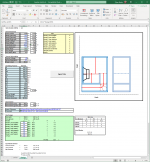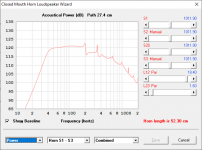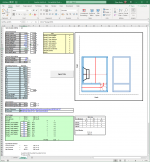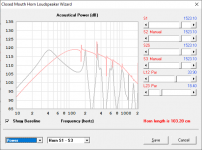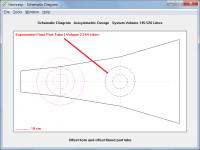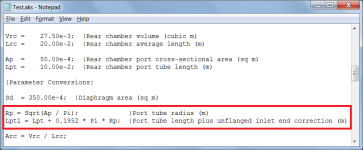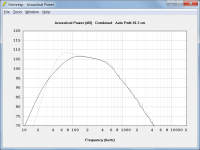Unfortunately it has proved to be just too much work to implement the above features in Hornresp.
Another one for AKABAK...
Thank you for even taking the time to look at it, David! And thank you for the endless patience and support. Be well!
Thank you for even taking the time to look at it, David! And thank you for the endless patience and support. Be well!
Hi grindstone,
I don't like giving up on something, and having to admit defeat 🙂. Sleeping on the problem overnight I think I might have come up with a different way of implementing the features you were seeking, which may just work and importantly, require less coding changes than the first approach. I will know more in the next day or so. Stay tuned...
Kind regards,
David
Hi grindstone,
I don't like giving up on something, and having to admit defeat 🙂. Sleeping on the problem overnight I think I might have come up with a different way of implementing the features you were seeking, which may just work and importantly, require less coding changes than the first approach. I will know more in the next day or so. Stay tuned...
Understood and thanks. No truly Great work is ever complete--True Greatness can only be Abandoned! 🙂
Not proud for having consumed this much of your time. Respect the persistence/technical sadism (Salute!)
Speaking of the latter...spent my evening in akabak 🙂 And of course I did pick the nastiest spot in HR to try to put that stuff -- in the OP area with the QL and the filling capability etc. Shot for the moon, you know? (Still can't believe I asked you for it at all but I also can't believe what people ask you for all the time). But that was sort of the point, too--to be able to apply a differently-behaving air mass/inertance tool in the OD/OP environment instead of just viscous damping or resonators--hopefully resulting in a better radiation resistance match w/o needing the length/resonance range of the straight ports...and, erm, with an easily controllable path distance 🙂 Well it's worse if you try to say it aloud (yes my eyes are watering, too).
Perhaps the more valuable/powerful feature of the two would be the facility to change an offset-port to flared and find the happy spot as normal in OD/OP? Might be wrong (no akabak expert here), but it seems the fronthorn is an easier "bolt-on" in akabak (and the other stuff is more cumbersome to iteratively optimize but would be a breeze in HR).
I can see a few ways at this, maybe the above ramble serves...something or other useful.
Thank you again.
Hi David, I discovered a minor "bug" with the BOXPLAN routine for Offset-Driver, Offset-Vent alignments. When the corresponding values in the workbook are set so that the resulting sim is a simple OD model instead, apparently the F6 refresh routine doesn't recognize this and still considers the line to be a closed one. However, if I import the same sim as a new record, it treats it like a normal OD sim.
To see what I'm talking about, download the BOXPLAN-VBSLOT workbook from my database, export the sim from it, import into Hornresp and start the Loudspeaker Wizard. Then, set the value for "vent extension" to zero in the workbook, select "Export Sim" again, and press F6 in Hornresp. Instead of recognizing it as a standard OD model (with stepped sections), it sees it as a closed model. However, import the same sim as a new record and it recognizes it correctly as a standard OD model with open mouth.
To see what I'm talking about, download the BOXPLAN-VBSLOT workbook from my database, export the sim from it, import into Hornresp and start the Loudspeaker Wizard. Then, set the value for "vent extension" to zero in the workbook, select "Export Sim" again, and press F6 in Hornresp. Instead of recognizing it as a standard OD model (with stepped sections), it sees it as a closed model. However, import the same sim as a new record and it recognizes it correctly as a standard OD model with open mouth.
Attachments
Last edited:
Hi David, I discovered a minor "bug" with the BOXPLAN routine for Offset-Driver, Offset-Vent alignments. When the corresponding values in the workbook are set so that the resulting sim is a simple OD model instead, apparently the F6 refresh routine doesn't recognize this and still considers the line to be a closed one. However, if I import the same sim as a new record, it treats it like a normal OD sim.
Hi Brian,
Thanks for the feedback and for the detailed description of the problem, it makes things so much easier for me. The reason for the difference in outcomes is because the routine used to import the initial BOXPLAN record into Hornresp is different to the one used when the F6 refresh key is pressed in the Loudspeaker Wizard. The F6 routine will be modified in the next update so that removal of the vent is recognized. Not sure when the update will be released, though - I am currently also trying to implement the two features requested by grindstone, which is proving to be quite a challenge 🙂.
Kind regards,
David
Gulp. Feeling pretty lousy about the magnitude of the work, David. Never meant to punish your good deed and it's clear no one could pay you enough for all the silent heroics. "Akabak" remains valid as a posting. (And I really didn't doubt that you had to bust your tail on the graphics bling, too).
Feeling pretty lousy about the magnitude of the work
Not a problem - I relish the challenge, and won't give up without a fight 🙂.
Hornresp Update 5300-210617
Hi Everyone,
CHANGE 1
When the Loudspeaker Wizard is refreshed after the vent extension parameter value in the BOXPLAN-VBSLOT workbook is set to zero, Hornresp now recognises that the vent extension has been removed. The post linked below refers:
https://www.diyaudio.com/forums/subwoofers/119854-hornresp-1217.html#post6685169
CHANGE 2
A loudspeaker with an offset direct radiator can now have an offset flared port tube. Attachment 1 refers.
Inputs:
Select the OD offset driver option and specify at least three segments, or select the OD1 offset driver option and specify four segments. Double-click on the Cir or Fta label in edit mode to select the Clo closed horn mouth option and set Vtc = 0. Specify the offset port using Ap and Lpt. An inner end correction is added to the Lpt port tube length.
Double-click on the Lpt label in edit mode to specify a flared port tube. Ap is the tube mouth cross-sectional area, Apt is the tube throat cross-sectional area and Lpt is the tube length.
CHANGE 3
A loudspeaker with an offset horn can now have an offset flared port tube. Attachment 2 refers.
Inputs:
Select the CH1 offset driver compound horn option and specify four segments. Double-click on the Cir or Fta label in edit mode to select the Clo closed horn mouth option. Double-click on the Ap1 label to specify the offset port using Ap and Lpt. An inner end correction is added to the Lpt port tube length.
Double-click on the Lpt label in edit mode to specify a flared port tube. Ap is the tube mouth cross-sectional area, Apt is the tube throat cross-sectional area and Lpt is the tube length.
CHANGE 4
Loudspeaker wizard absorbent filling material settings can now be switched on or off by pressing the F key. The chart caption changes from black to red when the settings are on.
BUG FIX 1
The offset port tube in a four segment OD system was not being shown on the schematic diagram or being taken into account in the simulation calculations. This has now been fixed. The post linked below refers:
https://www.diyaudio.com/forums/subwoofers/119854-hornresp-1213.html#post6670605
BUG FIX 2
The end correction formula in the AkAbak export file has been changed so that it is now the same as the one used in Hornresp. Attachment 3 and the post linked below refer:
https://www.diyaudio.com/forums/subwoofers/373301-vented-vs-tl-4.html#post6688205
NOTE
Changes 2 and 3 in particular required significant modifications to the existing code. Extensive testing has been done but it was simply not possible to check every configuration that can now be specified. For this reason it is quite likely that something has been overlooked or that there may be unintended consequences as a result of the work done to add the new features. It would be appreciated if you could you please report any bugs that you might find.
Kind regards,
David
Hi Everyone,
CHANGE 1
When the Loudspeaker Wizard is refreshed after the vent extension parameter value in the BOXPLAN-VBSLOT workbook is set to zero, Hornresp now recognises that the vent extension has been removed. The post linked below refers:
https://www.diyaudio.com/forums/subwoofers/119854-hornresp-1217.html#post6685169
CHANGE 2
A loudspeaker with an offset direct radiator can now have an offset flared port tube. Attachment 1 refers.
Inputs:
Select the OD offset driver option and specify at least three segments, or select the OD1 offset driver option and specify four segments. Double-click on the Cir or Fta label in edit mode to select the Clo closed horn mouth option and set Vtc = 0. Specify the offset port using Ap and Lpt. An inner end correction is added to the Lpt port tube length.
Double-click on the Lpt label in edit mode to specify a flared port tube. Ap is the tube mouth cross-sectional area, Apt is the tube throat cross-sectional area and Lpt is the tube length.
CHANGE 3
A loudspeaker with an offset horn can now have an offset flared port tube. Attachment 2 refers.
Inputs:
Select the CH1 offset driver compound horn option and specify four segments. Double-click on the Cir or Fta label in edit mode to select the Clo closed horn mouth option. Double-click on the Ap1 label to specify the offset port using Ap and Lpt. An inner end correction is added to the Lpt port tube length.
Double-click on the Lpt label in edit mode to specify a flared port tube. Ap is the tube mouth cross-sectional area, Apt is the tube throat cross-sectional area and Lpt is the tube length.
CHANGE 4
Loudspeaker wizard absorbent filling material settings can now be switched on or off by pressing the F key. The chart caption changes from black to red when the settings are on.
BUG FIX 1
The offset port tube in a four segment OD system was not being shown on the schematic diagram or being taken into account in the simulation calculations. This has now been fixed. The post linked below refers:
https://www.diyaudio.com/forums/subwoofers/119854-hornresp-1213.html#post6670605
BUG FIX 2
The end correction formula in the AkAbak export file has been changed so that it is now the same as the one used in Hornresp. Attachment 3 and the post linked below refer:
https://www.diyaudio.com/forums/subwoofers/373301-vented-vs-tl-4.html#post6688205
NOTE
Changes 2 and 3 in particular required significant modifications to the existing code. Extensive testing has been done but it was simply not possible to check every configuration that can now be specified. For this reason it is quite likely that something has been overlooked or that there may be unintended consequences as a result of the work done to add the new features. It would be appreciated if you could you please report any bugs that you might find.
Kind regards,
David
Attachments
It would be appreciated if you could you please report any bugs that you might find.
Oops, should read:
"It would be appreciated if you could please report any bugs that you might find."
(One less "you").
Loading, giddy, and grateful! It all sounds so simple in your changelog. OK, I think I'll be like the paraflex guys that disappeared after you did all that and disappear for a bit...
It all sounds so simple in your changelog.
Looks can be deceiving 🙂. I almost gave up several times, but I couldn't let it beat me...
The input rules are a bit complicated, but they are the best that I could come up with. One of the challenges was finding a way to input the necessary additional throat area value so that the port flare could be specified, without having to add to the input fields in the data record. In the end, I decided to sacrifice the throat chamber when an offset flared port is required.
Please let me know if you find any bugs - hundreds of changes have been made to the code so the potential for an error or two (or possibly even three?) is quite high.
like the paraflex guys that disappeared
I have been wondering for a while now if anyone is actually using the Hornresp paraflex models - the silence has been deafening 🙂.
I have been wondering for a while now if anyone is actually using the Hornresp paraflex models - the silence has been deafening 🙂.
It is my belief that they still have not come-up for air yet.
It will take time to come-up with useful feedback, but will endeavor to provide good code path coverage in due course. I'm already flummoxed by what it might have taught me. I have learned more in these minutes with this frighteningly complex masterpiece of joy than I have in the last 4 days in akabak... If I talk more, I'll spin-out like Boogerweldz 🙂
THANK YOU DAVID!!!!!!
For now, maybe open this thing, David, and just set L45 to 10 then 100 and 1000 and 10000 and 100000. Does that seem right? I'd think the extra compliance of the big volume would move things more than just affecting higher harmonics, but I've not had the chance to look at it harder--just a gut reaction-thing so treat it for what it's worth. Attached.
Attachments
Last edited:
Hold you're horses! The Paraflex community is hamering away at the Paraflex modals like mad men!
Last edited:
I have been wondering for a while now if anyone is actually using the Hornresp paraflex models - the silence has been deafening 🙂.
Depends on where you '**** an ear' 😉: High Order Quarterwave Society (DIY Paraflex & Super Planar dev community)
I have been wondering for a while now if anyone is actually using the Hornresp paraflex models - the silence has been deafening 🙂.
I see a lot of enthusiastic builds in the Paraflex facebook group but for some reason, the paraflex folks don't seem to care for measurements as much as they seem to care for sheer raw sensitivity. As far as I see, there isn't a single measurement in the HOQWS group. Probably because the group consists mostly of businessmen supplying gear for open air concerts rather than DIY enthusiasts that build out of passion, in their personal time.
Right, it's electronic based prosound, so 'loud is beautiful' even if it's not clean.......... 🙄
GM and Giri your both throwing in assumptions and IMHO not what I expected as a response in the DIY Audio group.
There is a lot of testing, data gathering modifications/improvements going. Almost all Discussion and data is shared in the Pro chats of the HOQS and is not visible on the public fb group page since most messages there are thrown into the FB 'black hole' in a day or two. We are still adjusting to the new modes in HR and getting actual measurements to the new modes in comparison. It's a learning process. The same happend when the TH mode was introduces in HR so give it some time for good feedback. It's all looking very positive with newer builds based on the new paraflex settings it almost mirror the actual measurements in comparison.
Nevertheless I will post all the measurement data I have gathered into the compound loading 6th quarterwave super planar horns-pipes concepts builds topic.
Maybe a moderator or Admin can rename the topic title to "HOQS Paraflex subwoofers" for a more general informative topic.
I think its a better place to post data than the HornResp topic. Unless there is specific information which compares HornResp sim vs measurement which might be interesting for David and others.
There is a lot of testing, data gathering modifications/improvements going. Almost all Discussion and data is shared in the Pro chats of the HOQS and is not visible on the public fb group page since most messages there are thrown into the FB 'black hole' in a day or two. We are still adjusting to the new modes in HR and getting actual measurements to the new modes in comparison. It's a learning process. The same happend when the TH mode was introduces in HR so give it some time for good feedback. It's all looking very positive with newer builds based on the new paraflex settings it almost mirror the actual measurements in comparison.
Nevertheless I will post all the measurement data I have gathered into the compound loading 6th quarterwave super planar horns-pipes concepts builds topic.
Maybe a moderator or Admin can rename the topic title to "HOQS Paraflex subwoofers" for a more general informative topic.
I think its a better place to post data than the HornResp topic. Unless there is specific information which compares HornResp sim vs measurement which might be interesting for David and others.
For now, maybe open this thing, David, and just set L45 to 10 then 100 and 1000 and 10000 and 100000. Does that seem right? I'd think the extra compliance of the big volume would move things more than just affecting higher harmonics
Hi grindstone,
Thanks for this feedback.
When I change the L45 (Par) value from 10 cm to 10000 cm in your example record the power response changes from the grey trace to the black trace in the attachment. In my case the lower frequency portion has been significantly altered. Are you seeing something different to this?
Also, just to check - you have set Ap (the port mouth area) to 200 sq cm and Apt (the port throat area) to 1200 sq cm. Did you mean to specify a negative exponential flare port, or should the figures perhaps be the other way around?
Serendipitously, in playing with the L45 slider in the Loudspeaker Wizard I discovered a minor bug that would have been there for ages - not one introduced with the latest release. I will try to fix it in the next day or so.
Kind regards,
David
Attachments
- Home
- Loudspeakers
- Subwoofers
- Hornresp
